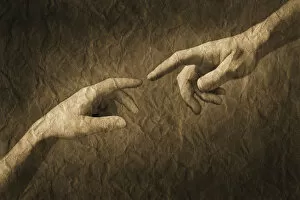Covet Collection
A peek into the past: This comic postcard from the 20th century depicts a man and woman, their eyes fixed on each other's possessions through a garden fence
All Professionally Made to Order for Quick Shipping
A peek into the past: This comic postcard from the 20th century depicts a man and woman, their eyes fixed on each other's possessions through a garden fence. The longing look exchanged between them is a timeless symbol of covetousness. Flashback to an earlier era, where a boy and girl are seen gazing at the same fence, their fingers almost touching, reflecting the same unspoken desire. The human condition of covetousness is as old as time itself. In "Great Expectations," Pip's desire for Estella's affection fuels his actions, leading him down a dangerous path. Similarly, in "The Pilgrim's Progress," "Lots Wife" is consumed by her desire for what she left behind, ultimately leading to her downfall. Augustin Hirschvogel's engraving "Woe is Pronounced on Covetousness" from 1549, and Albrecht Dürer's "A Courtier Standing Between Covetousness and Dissimulation" from 1512/1514, both depict the destructive power of covetousness. The phrase "You will unjustly desire your neighbor's wife" is a warning against the sin of covetousness, reminding us that desiring what isn't ours can lead to harm. Let us reflect on these depictions of covetousness throughout history and strive to cultivate contentment and gratitude in our own lives.










